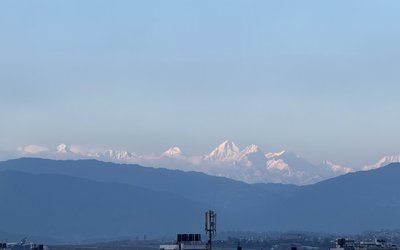
Climate Vulnerability and Resilience in West Asia
West Asia ranks among the most climate-vulnerable regions in the world due to the intensifying threats of extreme heat, prolonged drought, water scarcity, and rising sea levels. Countries such as Yemen, Syria, Iraq, and Iran are disproportionately exposed due to environmental stress and have a low adaptive capacity. The most recent drought across Syria, Iraq, and Iran, which lasted from 2020 to 2023, was attributed to human-induced climate change. Even wealthy nations like the United Arab Emirates (UAE), Saudi Arabia, and Qatar are highly exposed due to their dependence on desalination and fossil fuel and limited natural freshwater resources. Jordan is facing severe groundwater depletion, while coastal states grapple with saltwater intrusion. Weak governance, insufficient investment in climate adaptation, and unresolved trans-boundary water conflicts further heighten the region’s systemic vulnerability.
Between 2014 and 2024, the region endured a cascade of climate-related disasters including heat waves, wildfires, floods and cyclones that revealed deep institutional and governance gaps. In 2024, Iraq and Iran witnessed recurring droughts and dust storms; Jordan, Lebanon, and Syria experienced deadly flash floods; Yemen and Oman were battered by cyclones; and catastrophic flooding struck the UAE. These shocks laid bare the inadequacies of early warning systems, emergency response, and climate governance across much of the region. Slow progress in economic diversification in fossil fuel-reliant economies like Saudi Arabia and Kuwait compounds climate risks. Strengthening regional cooperation, investing in resilient infrastructure, accelerating green transitions, and scaling up adaptive capacity are critical to safeguarding the region’s future.
Key Climate Challenges and Barriers to Resilience in West Asia
Water scarcity and climate-induced stress: Water scarcity and climate-induced stress have sharply intensified across West Asia and its neighboring regions, posing severe threats to agriculture, public health, and socioeconomic stability. In Iraq, the relentless drought in 2023 caused major crop failures, forcing farmers to cut back cultivation and limit water use in response to the extreme heat. Jordan, which is among the most water-stressed nations in the world, faces severe groundwater depletion, pushing greater dependence on desalination and imports. Iran is dealing with acute water deficits in over 260 cities and critical land subsidence across 400 plains. As reported by Iran International Magazine on August 15, 2023, one quarter of its farming population has lost their livelihoods over the past seven years. In Gaza, access to clean water remains critically impaired, heightening public health risks. Elsewhere, Cyprus has had to launch emergency desalination efforts after successive dry winters caused dam reserves to shrink. Armenia’s rising temperatures and declining rainfall continue to strain agricultural output, while Azerbaijan, which depends on shared water resources, faces a projected 20–25% drop in water availability by 2050, threatening food security, as reported by Trend News Agency, on 25 September 2024. These converging crises underscore how climate-driven water stress is not only eroding livelihoods but also fueling migration, heightening public health vulnerabilities, and sharpening geopolitical tensions over increasingly scarce shared resources.
Weak climate governance and institutional gaps: Limited climate governance and institutional gaps in Yemen, Syria, Lebanon, Iran, and Georgia continue to undermine resilience-building, leaving millions exposed to accelerating climate threats. In Yemen, weak governance and limited access to climate finance hinder the rollout of adaptation strategies despite the fact that there are clear opportunities for targeted action. Much of Syria’s infrastructure was decimated and there was little environmental oversight during the civil war, outcomes that have worsened pollution and crippled disaster response mechanisms. Lebanon’s fragmented governance and limited coordination have stalled critical recovery initiatives, including the Reform, Recovery, and Reconstruction Framework (3RF). Iran struggles with regulatory shortcomings, limited institutional coordination, and an underdeveloped disaster management system, all flaws that limit its ability to respond effectively to recurring floods and earthquakes. In Georgia, low institutional capacity and inadequate climate risk preparedness magnify vulnerability to hazards. Across the region, structural deficiencies continue to delay adaptation, weaken early warning systems, and obstruct access to vital climate finance, leaving countries ill-equipped to confront the intensifying impacts of climate change.
Overdependence on fossil fuels and slow economic diversification: Overdependence on fossil fuels continues to obstruct economic diversification and climate resilience across several West Asian economies, thereby amplifying their long-term fiscal and environmental risks. As reported by Allianz, on January 2025, in Saudi Arabia, oil and gas activities accounted for nearly 50% of GDP in 2023, with 62% of state revenues still tied to hydrocarbons, despite the ambitious goals of Vision 2030. Kuwait is even more entrenched in hydrocarbons, with over 85% of its fiscal revenue and half of its GDP derived from oil, a fact that leaves it extremely exposed to market volatility (World Bank, 2024). These figures reflect deep structural vulnerabilities and highlight the urgent need for accelerating nations’ economic transformation away from fossil fuel. The UAE presents a partial success story: here, non-oil sectors contribute nearly 75% of GDP in 2024 though exposure to oil market shifts persists, as reported by Gulf Economist, on 2 January 2025. Qatar, while it has diversified by investing in tourism and infrastructure, remains heavily reliant on natural gas exports. Meanwhile, Azerbaijan's plans to boost fossil gas production reflect its focus on balancing energy security with long-term commitments to a green transition. These trends underscore the fragility of fossil fuel-based economies and the pressing imperative for regional cooperation, sustainable investment, and bold policy shifts to enable a just and resilient energy transition.
Urbanization and environmental degradation: Rapid, unregulated urbanization coupled with environmental degradation has amplified climate-related disaster risks in several countries. In Turkey, the 2021 Black Sea floods, which were exacerbated by riverbank construction and narrow floodplains, claimed 97 lives and caused $300 million in damage, exposing the dangers of poor urban planning. Similarly, Iran’s 2022 floods, exacerbated by deforestation and land mismanagement, ravaged 21 provinces, caused 95 fatalities, and resulted in over $200 million in agricultural losses. Armenia and Georgia faced severe flooding in May 2024, with Armenia’s Lori and Tavush provinces suffering significant infrastructural damage due to deforestation and alterations of river channels. According to One Green Planet (2023), Cyprus, grappling with long-term coastal erosion, faces a grim future, with projections indicating that 72% of its unprotected beaches could vanish by 2100 due to rising sea levels and storm surges. These events underscore the urgent need for sustainable urban planning and environmental conservation to safeguard communities and mitigate the escalating impacts of climate hazards.
Geophysical and climate-related hazards: Geophysical and climate-related hazards are exacerbating disaster risks and threatening sustainable development in Armenia, Georgia, Cyprus, and Azerbaijan. In Armenia, the magnitude 6.7 earthquake that struck Spitak in March 2025 highlighted the critical need for more stringent building standards and enhanced early warning systems in seismically active areas. Georgia’s devastating landslide in August 2023, which claimed 32 lives, was more devastating that it need have been due to the limited early warning system. Cyprus faces increasing wildfire threats fueled by prolonged dry spells and rising temperatures; these are likely to cause substantial environmental and economic damage. Azerbaijan, which grappled with a severe drought in 2023, one that affected 22% of its land area, has witnessed significant impacts on agriculture and water resources, as reported by AZERNEWS, on 28 August 2024. These events underscore the urgent need for comprehensive disaster risk management and climate adaptation strategies to safeguard the region’s resilience to both geophysical and climate-induced hazards.
Economic and institutional constraints to adaptation: Economic and institutional constraints are severely hampering climate adaptation efforts in Georgia, Azerbaijan, and Cyprus. That said, in Georgia, with support from UNDP and the Green Climate Fund, there is significant potential to strengthen institutional capacity and improve hazard mapping, paving the way for more effective climate risk management. Azerbaijan, because it hosted COP29, also has an opportunity to address governance challenges and strengthen its climate adaptation strategies. In Cyprus, growing climate hazards, such as wildfires and coastal erosion, emphasize the urgent need for enhanced climate finance and stronger institutional capacity. These challenges highlight the critical need for improved governance, better access to climate finance, and robust capacity-building efforts to ensure that the region engages in effective climate adaptation.
West Asia Climate Actions and the Role of UNDP
To address climate-induced stress and disaster risks, countries across West Asia and neighboring regions have implemented a range of strategies. Initiatives like the Arab Strategy for Disaster Risk Reduction (2010-2020) and the Gulf Cooperation Council Climate Change and Environment Strategy (2014) emphasize regional cooperation, emissions reduction, and the transition to renewable energy. Countries have aligned their actions with global climate goals, notably through the 2015 Paris Agreement. For instance, Jordan’s National Water Strategy (2016-2025) focuses on water efficiency, while the UAE's Climate Change Plan (2017) targets reducing emissions and increasing reliance on renewable energy. Saudi Arabia’s Vision 2030 aims to decrease oil dependence and Iran’s National Adaptation Plan (2015) prioritizes water conservation and sustainable agriculture. The Levant and Iraq Climate Change Resilience Program (2020) and Qatar's Food Security Program (2018) emphasize sustainable food and water management, reflecting a regional commitment to climate resilience and sustainable development.
Further, in response to the mounting climate impacts, countries are investing in significant measures to address water scarcity and enhance agricultural resilience. Iraq is improving irrigation infrastructure to mitigate the effects of drought, while Jordan is advancing wastewater treatment and desalination to reduce its dependence on groundwater. Iran is focusing on efficient irrigation practices and promoting water conservation to safeguard agriculture. International aid is crucial in Palestine, particularly Gaza, to rebuild water infrastructure and alleviate health risks caused by water shortages. Cyprus is bolstering desalination efforts and enhancing the efficient use of agricultural water. Armenia and Azerbaijan have adopted climate-resilient agricultural practices and are fostering regional cooperation on trans-boundary water management to address shared challenges. These efforts collectively represent a comprehensive approach which combines infrastructure upgrades, policy reforms, and regional collaboration to tackle water stress and its broader socioeconomic consequences.
To strengthen climate governance and fill institutional gaps, countries in the region are implementing various initiatives. Yemen is enhancing local governance structures and improving access to climate finance. Syria is rebuilding infrastructure and advancing environmental governance through international collaboration, thereby bolstering its disaster response capabilities. Lebanon is striving for better coordination via the Reform, Recovery, and Reconstruction Framework (3RF) although progress has been hindered by institutional fragmentation. Iran is updating disaster management regulations and improving inter-agency coordination, while Georgia is focused on building institutional capacity to prepare for climate risks. These efforts, which are supported by regional cooperation and international aid, aim to boost institutional capacities, improve disaster preparedness, and enhance resilience against climate-induced challenges.
Regional efforts to reduce overdependence on fossil fuels and diversify economies are also underway. Saudi Arabia's Vision 2030 is driving a shift away from oil dependence and paving the way for a more sustainable economy by calling for investing heavily in non-oil sectors such as renewable energy, tourism, and technology. Kuwait is progressing in diversification, with a focus on the finance and infrastructure sectors. According to the Ministry of Education (2024), the UAE’s successful diversification saw non-oil sectors contribute nearly 75% of GDP in 2024. Qatar remains reliant on natural gas but is expanding investments in infrastructure and tourism, while Azerbaijan is increasing fossil gas production but also planning long-term investments in renewables. These efforts highlight the need for robust policies to foster sustainable, diversified economies and reduce vulnerability to global fluctuations in the price of fossil fuel.
Rapid urbanization and environmental degradation continue to amplify climate-related risks. Turkey is enhancing urban resilience by enforcing stricter building codes and restoring floodplains, as demonstrated after the 2021 Black Sea floods. Iran’s reforestation programs and improved land management practices are combating the environmental factors that contributed to the 2022 floods. It is also reinforcing disaster risk management frameworks. Armenia and Georgia are focusing on flood mitigation, with Armenia prioritizing reforestation and Georgia addressing river channel modifications to mitigate flood risks. Cyprus is fortifying coastal protection, including seawalls, as part of a broader climate adaptation strategy to combat coastal erosion. These initiatives demonstrate the region’s commitment to sustainable urban development and environmental conservation to mitigate climate hazards.
In response to increasing risks from geophysical and climate-related hazards, countries are taking important steps. Armenia is strengthening building codes and enhancing early warning systems to mitigate the impacts of earthquakes, particularly in seismically active areas like Spitak. Georgia began to prioritize early warning systems and improving disaster response mechanisms following the 2023 landslide. Cyprus is bolstering fire prevention and management programs, improving land management, and enhancing wildfire response to address escalating risks from rising temperatures and dry spells. Azerbaijan is focusing on drought-resistant agriculture, water resource management, and improved early warning systems to combat the impacts of floods and droughts. These actions underline the region’s commitment to comprehensive disaster risk management and climate adaptation in building resilience against extreme events.
To overcome economic and institutional constraints to climate adaptation, countries are implementing significant strategies. Georgia, with support from UNDP and the Green Climate Fund, is strengthening institutional capacity and improving hazard mapping for better climate risk management. Azerbaijan, which organized COP29, is addressing governance challenges by promoting civil society engagement, diversifying its economy, and investing in resilience-building measures. Cyprus is focusing on enhancing climate finance mechanisms and strengthening institutional capacity to confront rising climate risks, including wildfires and coastal erosion. These efforts emphasize the need for improved governance, greater access to climate finance, and strengthened capacity-building for long-term adaptation.
UNDP plays a pivotal role in shaping climate and disaster risk management policies in the region through technical assistance, policy advice, and capacity-building support. It backs regional frameworks like the Arab Strategy for Disaster Risk Reduction (2010-2020) and the Arab Climate Change Action Plan (2012-2017), helping countries align with global commitments such as the Paris Agreement and nationally determined contributions. UNDP has also been instrumental in supporting Jordan’s National Water Strategy (2016-2040) to address water scarcity, Saudi Arabia’s Vision 2030 (2016) for reducing oil dependency, and the UAE’s National Climate Change Plan (2017-2050) to boost renewable energy. In addition, it aids the Levant and Iraq Climate Change Resilience Program (2020) to enhance water management and agricultural adaptation. Through these initiatives, UNDP strengthens governance, builds capacity, and fosters regional cooperation to address pressing climate challenges like water scarcity, environmental degradation, and extreme weather events.
Bridging Gaps in Climate Action
Despite its having made significant efforts, West Asia continues to grapple with profound water management challenges, particularly in agriculture. Countries like Iraq, Jordan, and Iran have initiated conservation measures such as irrigation upgrades and desalination projects, yet progress is hindered by financial limitations, policy inefficiencies, and limited regional cooperation. In Palestine, the conflict with Israel obstructs the rebuilding of crucial water infrastructure, exacerbating health risks. Overcoming these obstacles demands an integrated approach to water management, stringent policy enforcement, and enhanced cross-border collaboration to build climate resilience.
At the same time, weak climate governance and institutional shortcomings impede effective adaptation across the region. In Yemen, Syria, Lebanon, and Iran, fragmented systems delay disaster preparedness and climate action. Even in wealthy nations like Saudi Arabia, Kuwait, and Azerbaijan, heavy reliance on fossil fuels should incentivize efforts to accelerate economic diversification and enhance resilience in the face of fluctuations in the prices of energy on the global market. Saudi Arabia’s Vision 2030, with its focus on renewable energy and sustainable sectors, offers a glimmer of hope. Strengthening governance, expanding access to climate finance, and implementing robust diversification policies are crucial to ensuring long-term resilience and sustainability across the region.
Strategic Actions for Strengthening Climate Resilience in West Asia
To tackle water scarcity and climate-induced water stress, West Asia must prioritize regional cooperation on water resource management, particularly through trans-boundary agreements involving Iraq, Jordan, and Iran. Collaborative efforts to improve irrigation efficiency, expand desalination and wastewater treatment, and invest in sustainable water infrastructure are crucial. Financial mechanisms should enable the scaling up of water-saving technologies. In Palestine, rebuilding water systems and fostering community-level management, supported by international aid, are vital for mitigating health risks and enhancing resilience.
Weak climate governance and institutional gaps continue to impede adaptation, particularly in countries such as Yemen, Syria, Lebanon, and Georgia. Strengthening institutional capacities, disaster management systems, and inter-agency coordination is imperative. Greater access to international climate finance, stronger policy enforcement, and regional knowledge-sharing can enhance adaptive capacities. Establishing national disaster preparedness mechanisms and ensuring transparent climate finance allocation are essential in these countries for addressing both immediate and long-term climate challenges.
To reduce overreliance on fossil fuels, nations like Saudi Arabia, Kuwait, and Azerbaijan must accelerate investments in renewable energy and economic diversification. National strategies should focus on solar, wind, and other clean technologies while nurturing non-oil sectors such as tourism, agriculture, and green cutting-edge technologies. Encouraging the engagement of the private sector and academia and fostering regional collaboration on green innovation and infrastructure will help reduce vulnerability to fluctuations in energy markets and promote a more resilient, sustainable economic future. Making West Asia climate-resilient is not just a necessity for protecting the lives of 313 million people today; it is an imperative investment in the region’s future stability, prosperity, and sustainability.
Dr. Dhruba Gautam is an “Independent Evaluator and Consultant” with expertise in energy, natural resource management, climate resilience, and disaster risk reduction across the Asia-Pacific and Caribbean regions. The insights shared in this article are based on his extensive meta-evaluations of climate projects in the West Asia. For collaborations or inquiries, he can be reached at drrgautam@gmail.com
- Evaluation of Energy Transitions in Southeast Asia: Key Successes, Emerging Gaps and Major Takeaways for Adopting Green Energy
- Apr 14, 2025
- The Caribbean's Climate Crisis: A Call for Urgent Action
- Mar 14, 2025
- Renewable Energy-Sector Policy Initiatives And UNDP’s Role In The Pacific Region: The Path Ahead
- Mar 04, 2024
- Operationalization Of Nepal’s National Adaptation Plan: Institutionalizing A Monitoring, Review, And Reporting System Is Crucial
- Jan 09, 2024
- Building A Pacific Region Resilient To Climate Change: A Seven Step Approach Is Urgently Required
- Jan 04, 2024














